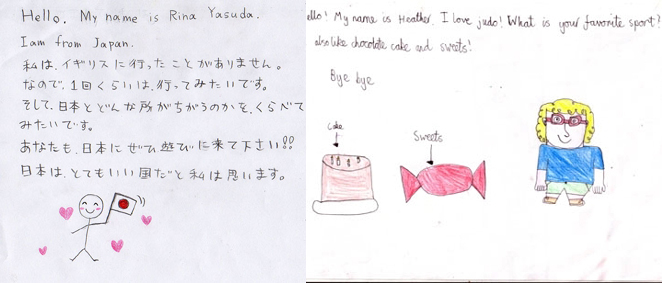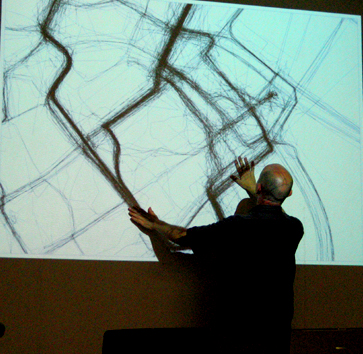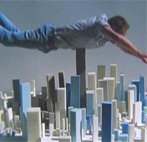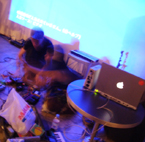touring japan/uk - children's collaboration project
In collaboration with Trampoline an 8 week education program was realized, working with schools in Kanagawa and Nottingham. This education program introduced the creative possibilities of simple new media and utilized this to communicate between the schools in each country. The initial results can be seen here: www.inter-play.org/2007
This program focuses upon engaging young people in international communication, basic new media skills and creative communication skills.
The workshops included a wide range of activities including video, photography and animation. The central motivation and point of focus for the workshops is collaboration and exchange between Japan and UK, with an exploration of how to communicate one environment to the other.

In daily life many children are deeply
involved in the Visual Media. However, their attitude to the
Visual Media is almost always passive such as watching TV or
playing computer games. To change their attitude toward the
Visual Media from a passive to an active way is crucial because
the Visual Media has prevailed in children’s a great deal. Here
the suggestion is, the lesson plan of making animation employing
the simple technique of hand-drawing so that children could
shift their position from receivers to expressers.
notion of place

This project is designed to facilitate communication between children on opposite sides of the world, to overcome barriers of language and preconceptions of each others’ context, and raise awareness of different cultures and cultural understanding. We aim to facilitate a creative dialogue between school children in UK and Japan and allow this dialogue to be expressed in a number of ways. This will include the main outputs of the project, but also a document of the developments of exchange to be facilitated from an online website/blog which all the children will be able to contribute to. This will be key to facilitating communication.
In these workshops we would like to explore the children’s views, their image, of what things are like in Japan (and the children in Japan will be exploring their views of UK). How do we form views of another place? How do we get information about another place? And how do we communicate where we are to elsewhere? These are important questions which will be raised in these activities.
Drawing

Our starting point was to imagine what the opposite place was like. What kind of houses did people live in? What kind of food did they eat? What did the buildings look like? What did people wear? What did people do in their leisure time? We began to think about these many questions and to consider if the answers might be different from our own experiences. We then began to draw the images which came to mind when thinking about the other place.

cardboard city

One way to explore these questions will be in the construction of a Japanese city, through the assimilation of children’s various ideas of what Japan is like. This will introduce principles of architecture and city planning in a creative and fun way. Using craft materials and cardboard we will create a virtual city using our imaginations of the opposite place. Later we will receive actual images from the opposite school of their experiences in Japan and also their imagination of UK.
photography

In order for the children to communicate their daily experiences, and the environment around them to the other group we used photography as a way to document and express these encounters. Every child was given a disposable camera and during the course of a week encouraged to take photos of the things which they find of interest, things which are important to them and things they would like to show to the other children. We then divided the large collection of photos into categories, including pets/animals, the home, nature, sports/hobbies, friends/family, transport etc. and uploaded them to the website under these categories, through which children could make direct comparisons of their experiences.

mapping



This comparison of experience and context was taken further through a mapping project. It was in this project which we made the most use of media technologies such as video, photography and sound recording.
This will also involve an overmapping activity in which the class in each city decides on a map of the local area a route that they would like to walk, they walk this route and take photos along the way – noting where each photo is taken. Then the opposite school is sent the map and asked to overlay this on to their local area – they follow the routes directions to the best of their ability and take photos at the same logistical points – they can then be uploaded to the website and the different environments compared.
animation

As further encouragement of creative exchange between the children, they were given the opportunity to contribute to a collaborative animation project. We encouraged the children to relate their animations somehow to the previous elements of the project – relating to city and place – but they were free to interpret this as they wished. Firstly the children began using a frame of a black ball and transformed this into another image. This image was then sent to the other school and the children here then transformed it further and then returned it to the image of a black ball. Then all the animations were put together to form something continuous.

messages

An important part of the project was to maintain communication between the different groups each week and to engage them in a dialogue despite language difference. We wanted to make it a personal experience for the children and allow them to relate with each other, despite not being in the same physical space. In order to achieve this in each session we would write/draw messages to the others with special greetings and also questions for each other. Many children were interested to know if the others had any pets, what kind of television program they like to watch and what their favourite sports/hobbies are.
Development
The education program was of great benefit to children in participating schools in Kanagawa and Nottingham. We believe it is vital to encourage this kind of creative and cultural communication and understanding at a young age. The children
benefitted from being introduced to new technologies which they may not have previously encountered and also from the demonstration of the imaginative uses of the technologies which may be very familiar to them. The program provided the children a key insight into environments which of their counterparts and promoted an appreciation and respect for similarities and differences between their contexts. Providing key opportunities relating to art, technology and cultural dialogue these activities also fed into the wider curriculum and encouraged the children's learning.








